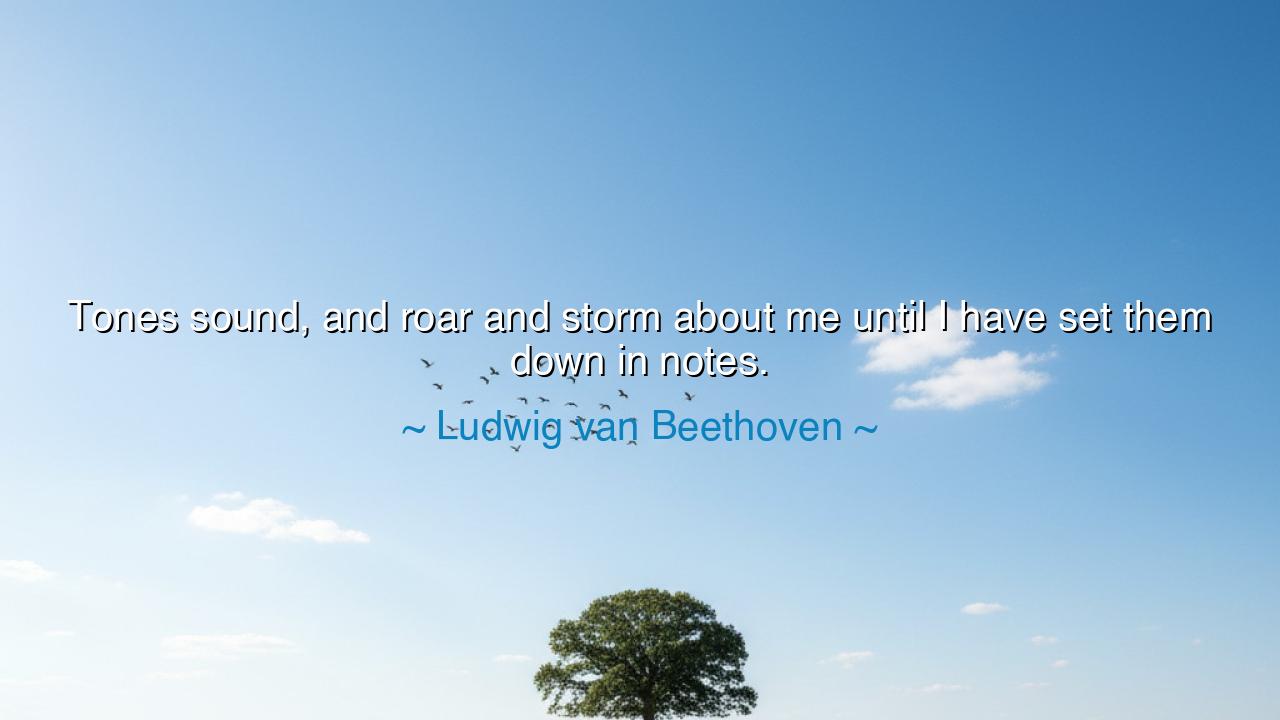
Tones sound, and roar and storm about me until I have set them






Ludwig van Beethoven, the titan of sound, once gave a glimpse into the storm of his genius when he confessed: “Tones sound, and roar and storm about me until I have set them down in notes.” In this image, we see not the calm of a composer arranging melodies at leisure, but the struggle of a prophet overwhelmed by visions of thunder, compelled to wrestle chaos into harmony. His words reveal the burden and the gift of the artist: to be possessed by creation until it is given form.
The tones of which Beethoven speaks are not gentle whispers, but elemental forces—like winds that shake the mountains, like seas that surge against the shore. To him, music was not a pastime but a destiny, an unstoppable torrent that demanded release. His mind was a furnace, filled with the roaring of ideas, each note glowing like molten metal, restless until forged into the shape of symphonies. This is the meaning of his quote: that true art is not chosen, but suffered, borne, and ultimately transformed into beauty.
We must remember, too, that Beethoven spoke these words as one who lived under the shadow of deafness. Even as the world grew silent to his ears, the roaring of tones within him only grew louder. Where others might have been crushed by despair, he endured, even defied fate, saying: “I will seize fate by the throat.” From his storming inner world came works that still shake the heavens—the Fifth Symphony, with its fateful knock; the Ninth, with its hymn to joy eternal. His torment became humanity’s treasure.
History gives us other examples of this same fire. Think of Michelangelo, who declared that his sculptures already lived within the marble, and that he merely freed them. Like Beethoven, he was hounded by visions until he gave them form. Or recall the poet Homer, who spoke of the Muse pouring words into his soul until he released them in epic song. The artist, in every age, is one pursued—driven by forces beyond themselves until their work is born into the world.
The wisdom here is profound: creation is not easy, nor is it quiet. It is often a tempest, a roaring that will not cease until it has been given voice. But in yielding to this storm, the artist transforms anguish into gift, chaos into order, fleeting inspiration into eternal beauty. Beethoven reminds us that greatness often comes not from comfort, but from wrestling with the inner roar until it becomes music.
The lesson, then, is for all who labor in the fields of creation: do not fear the storm within. When thoughts press upon you, when ideas demand release, when inspiration troubles your peace, see it not as torment but as calling. Write it, paint it, sing it, build it—whatever form it demands, give it life. For if ignored, it will roar endlessly; but if honored, it may rise into something greater than yourself, something that outlives you.
So, O seekers of tomorrow, let Beethoven’s words be your guide. Embrace the roar, endure the storm, and give birth to the tones that thunder within you. Do not wait for peace before creating, for peace may never come. Instead, let your art be the peace that follows the storm.
Thus remember always: the roar within is the seed of greatness. Like Beethoven, let the storm drive you, until you have set it down in notes, and what once tormented you becomes a gift to the world.






AAdministratorAdministrator
Welcome, honored guests. Please leave a comment, we will respond soon